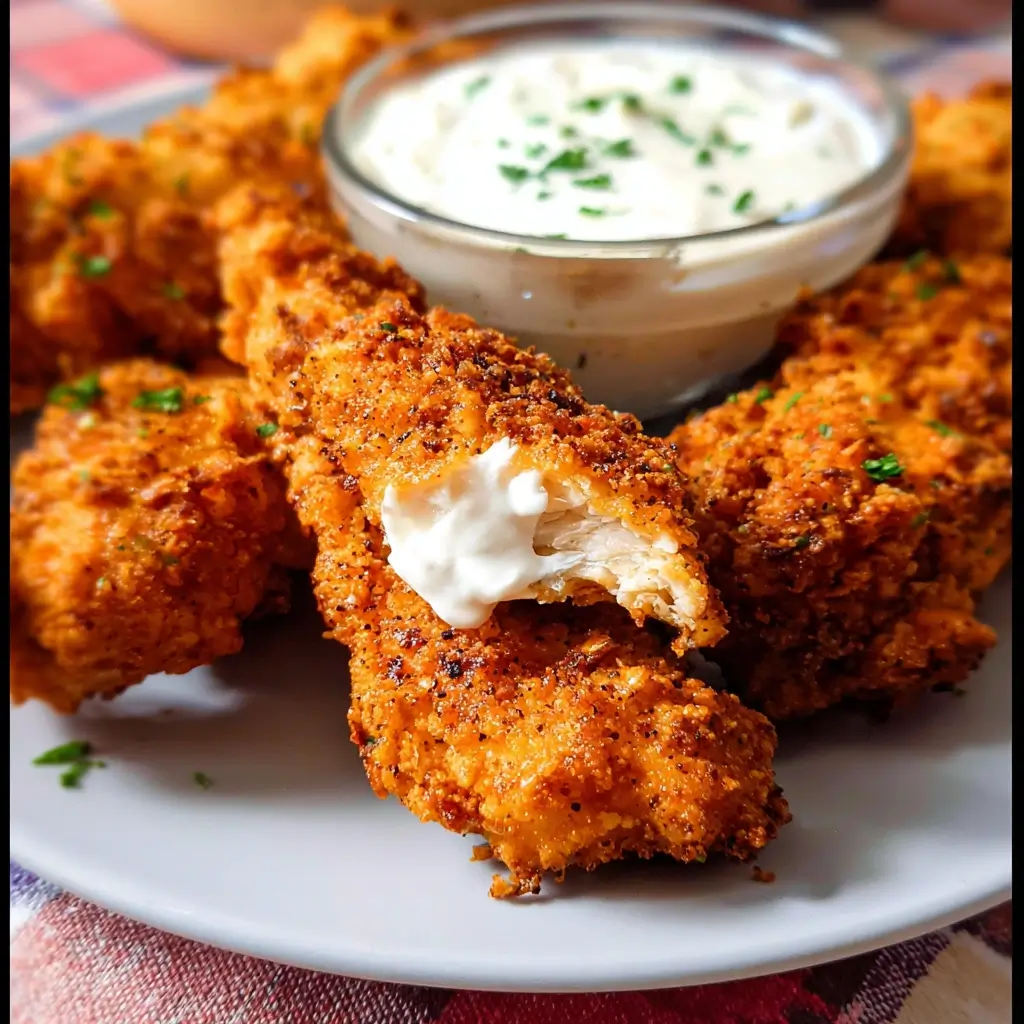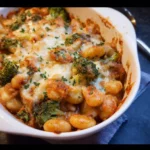Of all the comfort foods I thought I’d have to say a tearful goodbye to when I embraced the ketogenic lifestyle, classic fried chicken was at the top of the list. The crispy, crunchy, golden-brown coating, the juicy, tender meat inside… it felt like a culinary treasure locked away in a high-carb vault. For months, I tried to satisfy the craving with pan-seared chicken or baked chicken, but it just wasn’t the same. My family, ever supportive but also brutally honest, would politely eat my attempts and say, “It’s good, but it’s not fried chicken.” That was the challenge I needed. This recipe for Keto Fried Chicken Tenders is the triumphant result of that challenge. It’s not a “good for keto” substitute; it is, in its own right, spectacularly delicious fried chicken. The first time I served these, the sound of audible crunching from around the dinner table was music to my ears. My husband looked at me, wide-eyed, and said, “There’s no way this is low-carb.” My kids, notorious for their picky eating habits, devoured their portions and asked for more. This is the recipe that proves you don’t have to sacrifice flavor, texture, or your favorite family meals to stay on track with your health goals. The secret lies in a brilliant combination of pork rinds and almond flour, which creates a coating so flawlessly crispy and savory, you’ll fool even the most ardent carb-lover. They are perfect for a weeknight dinner, a game-day snack, or a crowd-pleasing party appetizer. Welcome back, fried chicken. We’ve missed you.
The Ultimate Crispy Keto Fried Chicken Tenders
This recipe has been meticulously tested to achieve the perfect balance of a crunchy, durable crust and moist, flavorful chicken. The key is the three-step dredging process and using the right combination of keto-friendly “breading” ingredients.
Ingredients:
- For the Chicken:
- 1.5 lbs (about 680g) boneless, skinless chicken tenders (or chicken breasts cut into 1-inch thick strips)
- 1 cup (240ml) unsweetened almond milk
- 1 tablespoon apple cider vinegar (or lemon juice)
- 1 teaspoon salt
- 1/2 teaspoon black pepper
- For the Keto Breading Station:
- Dish 1: The Base Coat
- 1/2 cup (56g) super-fine almond flour
- 1 teaspoon paprika
- 1/2 teaspoon garlic powder
- 1/2 teaspoon onion powder
- Dish 2: The Binder
- 2 large eggs
- 2 tablespoons heavy cream (or more unsweetened almond milk)
- Dish 3: The Crispy Crust
- 1.5 cups (about 4 oz or 113g) crushed pork rinds (pork panko works perfectly)
- 1/2 cup (56g) grated Parmesan cheese
- 1 teaspoon smoked paprika
- 1 teaspoon dried parsley
- 1/2 teaspoon salt
- 1/2 teaspoon black pepper
- 1/4 teaspoon cayenne pepper (optional, for a little heat)
- Dish 1: The Base Coat
- For Frying:
- 2-3 cups avocado oil, coconut oil, or lard (enough for about 1/2 inch of depth in your skillet)
Step-by-Step Instructions for Perfect Tenders
Follow these instructions carefully to ensure your breading sticks and your chicken cooks to golden-brown perfection. Organization is key, so set up your workspace before you begin.
- Marinate the Chicken (The “Keto Buttermilk”): In a medium bowl, combine the unsweetened almond milk and apple cider vinegar. Let it sit for 5-10 minutes to curdle slightly; this creates a keto-friendly “buttermilk” which will tenderize the chicken. Add the chicken tenders to the bowl, along with 1 teaspoon of salt and 1/2 teaspoon of black pepper. Stir to coat, cover, and let it marinate in the refrigerator for at least 30 minutes, or up to 4 hours for maximum tenderness.
- Prepare the Dredging Station: While the chicken marinates, prepare your three-part breading station. You’ll need three shallow dishes or plates.
- In the first dish: Whisk together the almond flour, paprika, garlic powder, and onion powder.
- In the second dish: Whisk the eggs and heavy cream together until smooth and uniform.
- In the third dish: Combine the crushed pork rinds, grated Parmesan cheese, smoked paprika, dried parsley, salt, black pepper, and optional cayenne pepper. Mix thoroughly to ensure the seasonings are evenly distributed.
- Set Up Your Workspace: Place the three dishes in a line next to your stove. After the dredging station, place a clean baking sheet or large plate where you can put the breaded chicken tenders before frying. Finally, have a wire cooling rack set over a baking sheet ready for the cooked chicken. This setup will make the process smooth and less messy.
- Dredge the Chicken Tenders: Remove the chicken from the marinade, allowing any excess liquid to drip off. Do not pat them dry; the moisture helps the first coat adhere. Working with one tender at a time, follow this process:
- Coat in Flour: Dredge the tender in the almond flour mixture (Dish 1), making sure it’s fully coated on all sides. Gently shake off any excess.
- Dip in Egg: Submerge the flour-coated tender into the egg wash (Dish 2), turning it to ensure it’s completely covered.
- Press into Crust: Transfer the tender to the pork rind mixture (Dish 3). Press the tender firmly into the crust on all sides. This is a critical step! Gently pressing the breading on helps it create a durable shell that won’t fall off during frying. Place the fully breaded tender on your clean baking sheet. Repeat with all remaining chicken tenders.
- Heat the Frying Oil: Pour your chosen frying oil into a large, heavy-bottomed skillet (a cast-iron skillet is ideal) to a depth of about half an inch. Heat the oil over medium-high heat until it reaches 350-360°F (175-180°C). Using a kitchen thermometer is highly recommended for best results. If you don’t have one, the oil is ready when a small piece of breading dropped in sizzles immediately and vigorously.
- Fry the Chicken Tenders: Carefully place the breaded chicken tenders into the hot oil in a single layer. Do not overcrowd the pan; fry in batches if necessary. Overcrowding will lower the oil temperature and result in soggy, greasy chicken.
- Fry for approximately 3-5 minutes per side. The exact time will depend on the thickness of your tenders. The crust should be a deep golden brown and crispy.
- Use tongs to carefully flip the tenders only once. Minimizing handling helps keep the crust intact.
- Check for Doneness and Rest: The chicken is cooked through when the internal temperature reaches 165°F (74°C) on an instant-read thermometer. Remove the cooked tenders from the skillet and place them on the prepared wire cooling rack. This allows air to circulate, keeping the bottom of the tenders just as crispy as the top. Let them rest for a few minutes before serving.
Nutrition Facts
- Servings: This recipe makes approximately 6 servings.
- Serving Size: About 3-4 chicken tenders, depending on size.
- Calories Per Serving (Approximate): 485 kcal
Disclaimer: The nutritional information is an estimate and can vary depending on the specific ingredients used (e.g., brand of pork rinds, size of chicken tenders) and the amount of oil absorbed during frying.
- Fat: 35g
- Protein: 40g
- Total Carbohydrates: 4g
- Fiber: 1g
- Net Carbohydrates: 3g
Preparation Time
- Prep Time: 15 minutes
- Marinating Time: 30 minutes
- Cook Time: 20 minutes
- Total Time: 1 hour 5 minutes
How to Serve Your Keto Chicken Tenders
These versatile tenders can be the star of many different meals. Here are some delicious and low-carb ways to serve them:
- Classic Tenders and Dip:
- Keto Ranch Dressing: A creamy, herby classic.
- Spicy Mayo: Mix mayonnaise with sriracha or another sugar-free hot sauce and a squeeze of lime.
- Sugar-Free BBQ Sauce: Many great store-bought options are now available.
- Keto “Honey” Mustard: Combine dijon mustard, yellow mustard, mayonnaise, and a powdered keto sweetener like erythritol or allulose.
- As a Main Course with Sides:
- Serve alongside a heaping portion of Creamy Keto Coleslaw.
- Pair with Cauliflower Mac and Cheese for the ultimate comfort food experience.
- Enjoy with a side of Garlic Butter Green Beans or Bacon-Wrapped Asparagus.
- Serve with Loaded Cauliflower Mash (cauliflower mashed with butter, sour cream, chives, and bacon).
- In a Keto-Friendly Meal:
- Keto Chicken Tender Salad: Chop up the tenders and serve them over a bed of fresh romaine lettuce with cherry tomatoes, cucumbers, avocado, and your favorite keto dressing.
- Low-Carb “Chicken and Waffles”: Serve the tenders on top of freshly made chaffles (cheese and egg waffles) and drizzle with a sugar-free maple syrup.
- Keto Chicken Parmesan Style: Place the cooked tenders in a baking dish, top with a low-carb marinara sauce and a slice of mozzarella cheese, then bake until the cheese is bubbly and melted.
- Chicken Tender Wraps: Use large lettuce leaves (like iceberg or butter lettuce) or a low-carb tortilla to wrap the tenders with bacon, ranch, and sliced tomato.
Additional Tips for Success
Here are five expert tips to take your keto fried chicken tenders from great to absolutely unforgettable.
- Don’t Skip the Marinade: The “keto buttermilk” marinade is not just for flavor; it’s a crucial step for tenderness. The acidity in the vinegar or lemon juice helps to break down the proteins in the chicken, resulting in a much juicier and more tender final product. Even 30 minutes makes a significant difference.
- Pork Panko is Your Best Friend: For the crispiest crust, use “pork panko,” which is simply finely ground pork rinds. You can buy it pre-made or make your own by crushing regular pork rinds in a food processor or in a zip-top bag with a rolling pin. The fine, uniform texture adheres better and creates an even, unbelievably crunchy coating that mimics traditional panko breadcrumbs.
- Chill Before You Fry: For an extra-durable crust that absolutely will not fall off, place the breaded, uncooked chicken tenders on a baking sheet and chill them in the refrigerator for 15-20 minutes before frying. This small step helps the coating “set” and adhere firmly to the chicken, making it more resilient in the hot oil.
- Master Your Cooking Method (Pan-Fry, Air Fry, or Bake):
- Pan-Frying (Recommended): This method provides the most authentic, crispy, golden-brown result. The key is maintaining oil temperature.
- Air Fryer Method: For a slightly healthier version, preheat your air fryer to 400°F (200°C). Place the tenders in a single layer in the basket and spray them generously with avocado or coconut oil spray. Air fry for 10-12 minutes, flipping halfway through, until golden and cooked through.
- Oven-Baked Method: Preheat your oven to 425°F (220°C). Place the breaded tenders on a wire rack set inside a baking sheet. Spray the tops with oil. Bake for 15-20 minutes, flipping once, until cooked through and crispy. They won’t be quite as crunchy as fried, but they are still incredibly delicious.
- Reheat Like a Pro: Never, ever reheat leftover fried chicken in the microwave unless you enjoy a sad, soggy mess. The best way to bring back the crunch is to use an oven or air fryer. Place the leftover tenders in a single layer and heat at 375°F (190°C) for 5-8 minutes, or until hot and crispy again.
Frequently Asked Questions (FAQ)
1. Why is my keto breading falling off the chicken?
This is the most common issue, and it usually comes down to a few key mistakes. First, ensure you follow the three-step dredging process (flour -> egg -> crust) in that exact order. The almond flour base gives the egg something to cling to, and the egg acts as the glue for the final pork rind crust. Second, make sure you are pressing the pork rind mixture firmly onto the tender. Third, your oil temperature might be too low. If the oil isn’t hot enough, the chicken sits in it for too long, causing the crust to absorb oil and fall apart. Finally, don’t overcrowd the pan and only flip the tenders once.
2. Can I make this recipe without pork rinds?
Yes, but with a trade-off in crispiness. Pork rinds are the gold standard for a crunchy keto crust because they are essentially fried fat and protein, which re-fries beautifully. If you cannot or do not want to use them, you can substitute the pork rind mixture with a combination of 1 cup of almond flour and 1 cup of grated Parmesan cheese, plus the seasonings. The result will be more like a breaded cutlet than a crispy fried tender, but still delicious. Another option is using unflavored whey protein isolate mixed with Parmesan, which also creates a decent crust.
3. Are these chicken tenders also gluten-free?
Absolutely! Since the “breading” is made from almond flour, pork rinds, and Parmesan cheese, this recipe is naturally 100% gluten-free. This makes it a fantastic and safe option for anyone with celiac disease or gluten sensitivity, not just those on a keto diet.
4. What is the best and healthiest oil for frying on a keto diet?
The best oils for high-heat frying are those with a high smoke point and a stable fatty acid profile. On a keto diet, excellent choices include:
- Avocado Oil: Very high smoke point (around 520°F) and a neutral flavor.
- Lard or Tallow: Traditional, stable animal fats that impart a wonderful flavor.
- Coconut Oil (Refined): Has a higher smoke point (around 400°F) and a more neutral flavor than virgin coconut oil.
Avoid industrial seed oils like canola, corn, soy, or vegetable oil, as they are less stable at high heat and are generally discouraged on a clean keto diet.
5. How do I know for sure when the chicken is cooked, without overcooking it?
The single most important tool for cooking any meat perfectly is an instant-read digital thermometer. Color and time are unreliable indicators. Chicken is safe to eat and perfectly cooked when the internal temperature in the thickest part of the tender reaches 165°F (74°C). If you pull it from the oil at 160-162°F, carryover cooking will usually bring it up to the perfect temperature as it rests. This guarantees a juicy, tender piece of chicken that is fully cooked and safe, without any of the guesswork that leads to dry, overcooked meat.

Crispy Keto Fried Chicken Tenders Recipe
Ingredients
- For the Chicken:
- 1.5 lbs (about 680g) boneless, skinless chicken tenders (or chicken breasts cut into 1-inch thick strips)
- 1 cup (240ml) unsweetened almond milk
- 1 tablespoon apple cider vinegar (or lemon juice)
- 1 teaspoon salt
- 1/2 teaspoon black pepper
- For the Keto Breading Station:
- Dish 1: The Base Coat
- 1/2 cup (56g) super-fine almond flour
- 1 teaspoon paprika
- 1/2 teaspoon garlic powder
- 1/2 teaspoon onion powder
- Dish 2: The Binder
- 2 large eggs
- 2 tablespoons heavy cream (or more unsweetened almond milk)
- Dish 3: The Crispy Crust
- 1.5 cups (about 4 oz or 113g) crushed pork rinds (pork panko works perfectly)
- 1/2 cup (56g) grated Parmesan cheese
- 1 teaspoon smoked paprika
- 1 teaspoon dried parsley
- 1/2 teaspoon salt
- 1/2 teaspoon black pepper
- 1/4 teaspoon cayenne pepper (optional, for a little heat)
- Dish 1: The Base Coat
- For Frying:
- 2–3 cups avocado oil, coconut oil, or lard (enough for about 1/2 inch of depth in your skillet)
Instructions
- Marinate the Chicken (The “Keto Buttermilk”): In a medium bowl, combine the unsweetened almond milk and apple cider vinegar. Let it sit for 5-10 minutes to curdle slightly; this creates a keto-friendly “buttermilk” which will tenderize the chicken. Add the chicken tenders to the bowl, along with 1 teaspoon of salt and 1/2 teaspoon of black pepper. Stir to coat, cover, and let it marinate in the refrigerator for at least 30 minutes, or up to 4 hours for maximum tenderness.
- Prepare the Dredging Station: While the chicken marinates, prepare your three-part breading station. You’ll need three shallow dishes or plates.
- In the first dish: Whisk together the almond flour, paprika, garlic powder, and onion powder.
- In the second dish: Whisk the eggs and heavy cream together until smooth and uniform.
- In the third dish: Combine the crushed pork rinds, grated Parmesan cheese, smoked paprika, dried parsley, salt, black pepper, and optional cayenne pepper. Mix thoroughly to ensure the seasonings are evenly distributed.
- Set Up Your Workspace: Place the three dishes in a line next to your stove. After the dredging station, place a clean baking sheet or large plate where you can put the breaded chicken tenders before frying. Finally, have a wire cooling rack set over a baking sheet ready for the cooked chicken. This setup will make the process smooth and less messy.
- Dredge the Chicken Tenders: Remove the chicken from the marinade, allowing any excess liquid to drip off. Do not pat them dry; the moisture helps the first coat adhere. Working with one tender at a time, follow this process:
- Coat in Flour: Dredge the tender in the almond flour mixture (Dish 1), making sure it’s fully coated on all sides. Gently shake off any excess.
- Dip in Egg: Submerge the flour-coated tender into the egg wash (Dish 2), turning it to ensure it’s completely covered.
- Press into Crust: Transfer the tender to the pork rind mixture (Dish 3). Press the tender firmly into the crust on all sides. This is a critical step! Gently pressing the breading on helps it create a durable shell that won’t fall off during frying. Place the fully breaded tender on your clean baking sheet. Repeat with all remaining chicken tenders.
- Heat the Frying Oil: Pour your chosen frying oil into a large, heavy-bottomed skillet (a cast-iron skillet is ideal) to a depth of about half an inch. Heat the oil over medium-high heat until it reaches 350-360°F (175-180°C). Using a kitchen thermometer is highly recommended for best results. If you don’t have one, the oil is ready when a small piece of breading dropped in sizzles immediately and vigorously.
- Fry the Chicken Tenders: Carefully place the breaded chicken tenders into the hot oil in a single layer. Do not overcrowd the pan; fry in batches if necessary. Overcrowding will lower the oil temperature and result in soggy, greasy chicken.
- Fry for approximately 3-5 minutes per side. The exact time will depend on the thickness of your tenders. The crust should be a deep golden brown and crispy.
- Use tongs to carefully flip the tenders only once. Minimizing handling helps keep the crust intact.
- Check for Doneness and Rest: The chicken is cooked through when the internal temperature reaches 165°F (74°C) on an instant-read thermometer. Remove the cooked tenders from the skillet and place them on the prepared wire cooling rack. This allows air to circulate, keeping the bottom of the tenders just as crispy as the top. Let them rest for a few minutes before serving.
Nutrition
- Serving Size: One Normal Portion
- Calories: 485
- Fat: 35g
- Carbohydrates: 4g
- Fiber: 1g
- Protein: 40g





